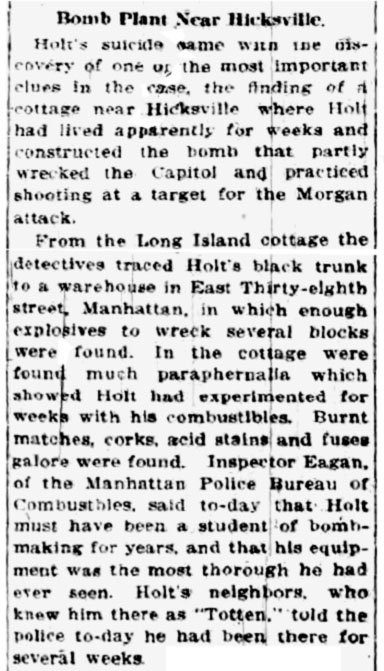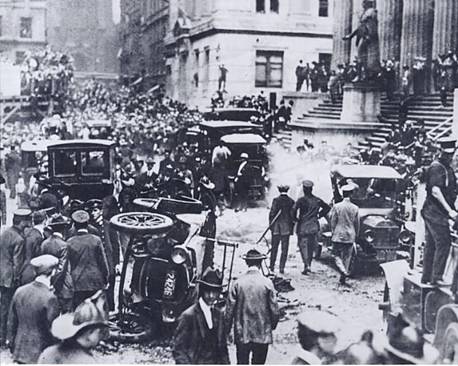A Worrisome Tradition
None of us who were alive on September 11, 2001 will forget the terrible events of that day. They changed our world forever, and in their aftermath, our everyday vocabulary grew to include words like terrorist, and phrases like Improvised Explosive Device.
It is tempting for us to think that before that day, back in our childhood, life was far more innocent. Although that belief is true in many ways, greater New York has a long history of terrorist incidents and IEDs. For example, in the late 19th century, communists and anarchists were active in western Queens. Both sides believed in the use of violence, including the hiding of bombs in crowded places, to achieve their aims.
Daily Eagle, April 11, 1893
Thus, in the early 1890s, anarchists planted multiple bombs underneath a factory in Maspeth, Queens. Due to strife within the group - not surprising; the idea of organized anarchists seems at best a paradox - the plans were leaked to the police, and a date for detonating the bombs was never set.
*
In 1898, a waterlogged, unexploded pipe bomb was discovered on a beach in Westhampton. Was it related to the Spanish-American War? Was it a failed test bomb for some unknown plot? No one knew.
*
It is surprising to learn that Hicksville once played a small but crucial part in a terrorist incident of national, even international, significance. In July 1915, Erich Meunter, believed to have been a German agent, put a time-bomb in the foyer of the U.S. Senate. Before it exploded, he was on his way back to New York, where he concealed another bomb on a munitions ship bound for England. For good measure, he made a surprise dinnertime visit to a Long Island estate and shot J.P. Morgan, but the wounded man managed to overpower his would-be assassin.

Wife Murderer, Former Professor, and Terrorist: Erich Meunter, alias Frank Holt
Syracuse Journal, July 15, 1915
After the suicide of the spy / terrorist, officials learned that he had constructed his bombs, and practiced his shooting, at a cottage in Hicksville. It is likely that he gained access to the property by making connections with members of the hospitable local German-American community.

Brooklyn Daily Standard, July 7, 1915
*
In September 1920, 38 people died, and hundreds more were injured, when a bomb concealed in a horse-drawn wagon exploded at noon, across from the offices of J.P. Morgan & Company at 23 Wall Street. At the time, it was the worst terrorist attack in the nation's history.

http://en.wikipedia.org/wiki/Image:Wallstreetbmb.jpg
Although the perpetrators were never discovered, it is believed to have been the work of a known cell of anarchists, responsible for exploding bombs elsewhere around that time.
*
A decade later, an unexploded live pipe bomb, filled with shrapnel, was found near the intersection of New South and Plainview Roads, possibly dumped there when someone had second thoughts about using it in an attack.

Huntington Long-Islander, July 25, 1930
*
Bombings were infrequent and unpredictable, but they never really went away. Criminal organizations would occasionally use bombs. One especially notorious criminal bombing occurred in Queens in 1931. It targeted neither a mobster nor his criminal enterprise, but his family while they were at home. Three young children were killed by the explosion.
At the 1940 New York World's Fair, a time-bomb exploded, killing two people. The person(s) responsible remain unknown. This was the "last straw" for Mayor Fiorello LaGuardia: he directed the NYPD to establish a permanent Bomb Squad, and to use expert knowledge to devise vehicles in which live IEDs could be transported safely.
*
Older readers will recall, and their children may remember being told about, New York's prolific letter-writing Mad Bomber. George Metesky, a quiet, clever, meticulous, and disturbed man, dedicated his adult life to terrorizing New Yorkers, in hopes of wreaking revenge upon Consolidated Edison. He began placing bombs in public places in 1940, but he soon took a hiatus - a letter to the public explained that it would be unpatriotic for him to continue to plant bombs in wartime! Nonetheless, he still wrote letters during World War II, in hopes that that they would be published. He resumed his "work" in 1951.

Plea for the Public's Assistance
Excerpts from New York Daily News, December 12, 1956
Thanks to what likely was the first instance of criminal profiling, Metesky finally was arrested at his Connecticut home in 1957. By then, he had planted 33 bombs in public places. Some were duds, some were found and disarmed, but 22 of them exploded, injuring 15 innocent people.
***

